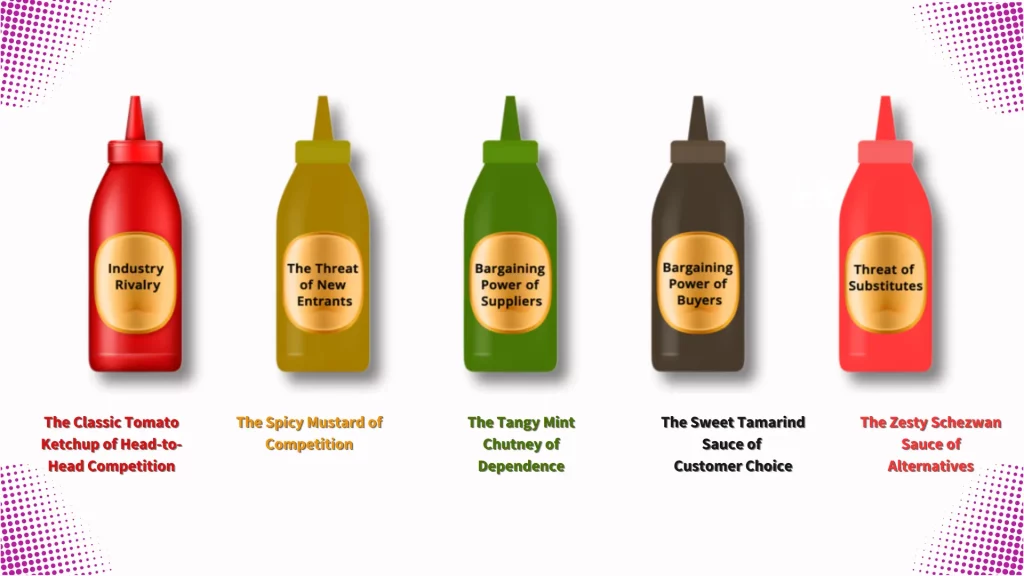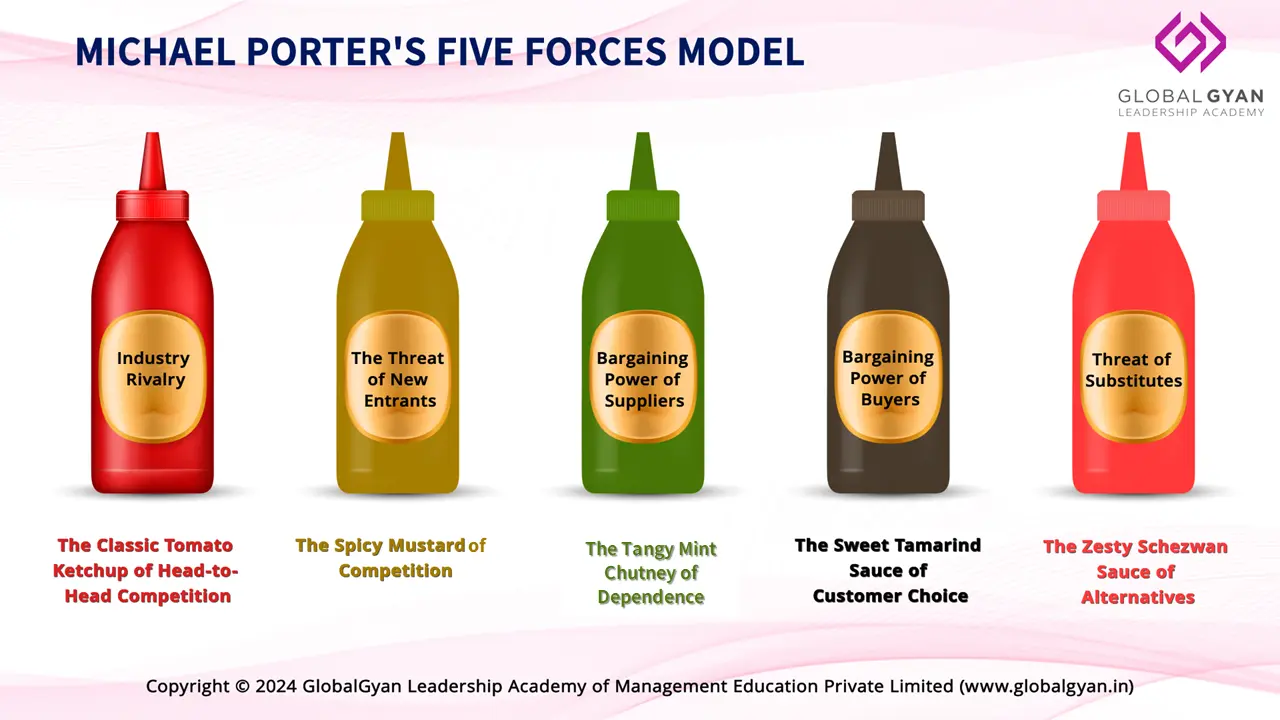The Secret Sauce of Strategy: 5 Case Studies That Show Why Porter’s 5 Forces Still Matter

Imagine biting into a perfectly layered sandwich—the bread is fresh, the fillings are balanced, and the sauces bring it all together in a burst of flavours.
Now, imagine your business strategy as that sandwich. The secret to making your business strategy a masterpiece lies in understanding the unique flavours of your competitive landscape—Michael Porter’s Five Forces model is your chef’s guide.
Even decades after its introduction, Porter’s model remains vital in today’s business world. With markets evolving due to globalization, technology, and shifting consumer demands, this framework provides timeless insights to decode competition and craft strategies that stand the test of time.
What is Porter’s Five Forces Model?
Porter’s Five Forces is a model that helps businesses understand the competitive landscape. It focuses on five key factors:
- Threat of New Entrants – How easily new competitors can enter the market.
- Bargaining Power of Suppliers – The influence suppliers have on your costs.
- Bargaining Power of Buyers – How much power customers have over your pricing.
- Threat of Substitutes – The risk of customers switching to alternatives.
- Industry Rivalry – The level of competition between existing players.
These forces shape the market dynamics and help businesses create effective strategies.
Let’s uncover how Porter’s Five Forces continues to shape winning strategies in the modern era.

The Key Ingredients: Understanding Porter’s Five Forces
- The Threat of New Entrants: The Spicy Mustard of Competition
This force measures how easy it is for new players to enter your market. If new entrants can quickly step in and compete, they can dilute your market share and profits. Factors like low startup costs, minimal regulatory hurdles, and easy access to resources can make markets vulnerable to new entrants.
When Jio entered the telecom industry in 2016, it disrupted the market by offering free data and calling services. Backed by significant financial resources from Reliance, Jio swiftly overcame entry barriers and set a world record by acquiring 16 million subscribers within just 26 days.
Think of your market as a crowded food stall at a busy fair. If anyone can easily set up a stall next to yours and offer the same snacks, standing out becomes a real challenge. To mitigate this threat, focus on creating a unique offering your “secret sauce” whether it’s a distinctive product, strong customer loyalty, or an unbeatable brand presence. By differentiating yourself, you reduce the chances of being overshadowed by new competitors.
- Bargaining Power of Suppliers: The Tangy Mint Chutney of Dependence
Suppliers are the ones who provide the raw materials, tools, or services you need to run your business. If they hold too much power (e.g., few suppliers, high demand), they can increase costs, impacting your profits.
After 2015, Netflix faced conflicts as studios like Disney and Warner Bros. withdrew content to launch their own platforms. Disney’s exit in 2019 reduced Netflix’s U.S. library by over 30%, highlighting supplier power. To counter this, Netflix invested over $17 billion in original content by 2020, creating hits like Stranger Things to reduce dependence on external suppliers.
Think of suppliers as the vendors behind the scenes at your food stall. If there’s only one or two suppliers who provide the key ingredients you need, they hold the power to decide the prices and quality of what you sell. Now, if those prices go up, your profits take a hit. To reduce this dependency, consider diversifying your supply chain or even building stronger relationships with multiple suppliers. This will allow you to secure better pricing and ensure your business isn’t at the mercy of just one supplier’s decisions. By diversifying and strengthening supplier relationships, you gain more control over your costs and maintain a stable, profitable business.
- Bargaining Power of Buyers: The Sweet Tamarind Sauce of Customer Choice
Buyers (your customers) can influence your pricing and offerings, especially if they have many options to choose from. High buyer power means they can demand lower prices or better service, squeezing your profitability.
Customers exhibit high bargaining power, as their ability to choose between platforms drives competition. Amazon’s extended “Great Indian Festival,” lasting up to a month, creates sustained purchase opportunities, while Flipkart’s shorter “Big Billion Days” sale builds urgency, highlighting how customer preferences shape sales strategies.
Think of a sandwich shop where every vendor offers the same basic sandwich. If one vendor increases their prices, the customer can easily walk to the next stall. But if your sandwich has a unique filling or special sauce no one else can replicate, customers will keep coming back—even if you charge a bit more. To reduce buyer power, focus on differentiation—offer something special that makes customers choose you, even at a premium.
- Threat of Substitutes: The Zesty Schezwan Sauce of Alternatives
Substitutes are products or services that meet the same customer need in a different way. If customers can easily switch to a substitute, your market position becomes weaker.
In 1986, Burger King’s profits fell by 40% due to the failure of the “Where’s Herb?” advertising campaign. The campaign was aimed at getting people to choose Burger King over competitors like McDonald’s. However, the confusion and lack of appeal in the campaign made customers less likely to choose Burger King. When customers don’t find what they’re looking for, they easily turn to substitutes
Imagine you run a sandwich shop, and suddenly, a momos stall opens across the street. If customers see momos as a cheaper or tastier alternative to sandwiches, you could lose business. To stay competitive, you might innovate how about a momo-sandwich fusion that combines the best of both worlds? To defend against substitutes, keep innovating and offer unique options that make customers prefer your product over alternatives.
- Industry Rivalry: The Classic Tomato Ketchup of Head-to-Head Competition
This force evaluates the intensity of competition among existing players in your industry. High competition means lower profitability, while low competition allows businesses to thrive. Factors like the number of competitors, market growth rate, and product differentiation drive rivalry.
Maruti Suzuki continues to dominate the top 10 car brands in December, maintaining a significant market share. However, competitors like Tata Motors are gaining momentum, with the Tata Punch emerging as a leader for 2024. This shift highlights the growing rivalry among brands, influencing market trends and consumer preferences.
Think of your business as one of many cricket teams in the IPL. The competition is intense, and every team is vying for the trophy (customers). To win, you need a strong strategy, loyal fans, and a star player (your unique selling point) to stand out in the crowd. To succeed in a competitive market, differentiate yourself and build a loyal customer base that makes you their team of choice.
Crafting the Perfect Sandwich
Just as every chef starts with understanding their ingredients, businesses must begin with a clear analysis of their competitive landscape. Michael Porter’s Five Forces isn’t just a theoretical model—it’s a practical framework that can help you craft strategies that stand out in today’s crowded marketplace.
Here’s how you can move forward:
- Conduct a Comprehensive Market Analysis: Map out each force in your industry. Identify where threats, opportunities, and leverage points lie—from new entrants to substitute products.
- Develop Targeted Strategies: Use insights from your analysis to fortify your position. For example, if supplier power is high, diversify your sources or negotiate better terms. If industry rivalry is intense, differentiate your offerings to create a unique competitive edge.
- Iterate and Adapt: The market is dynamic. Continuously revisit the Five Forces as new players, technologies, and customer preferences emerge. Treat this framework as a living tool to refine your strategies and remain ahead of the curve.
By balancing these forces, you can create a strategy that doesn’t just react to competition but proactively shapes your market position. So, take a bite of this model and start crafting your business strategy today. After all, the secret to success is in the sauce.






Responses